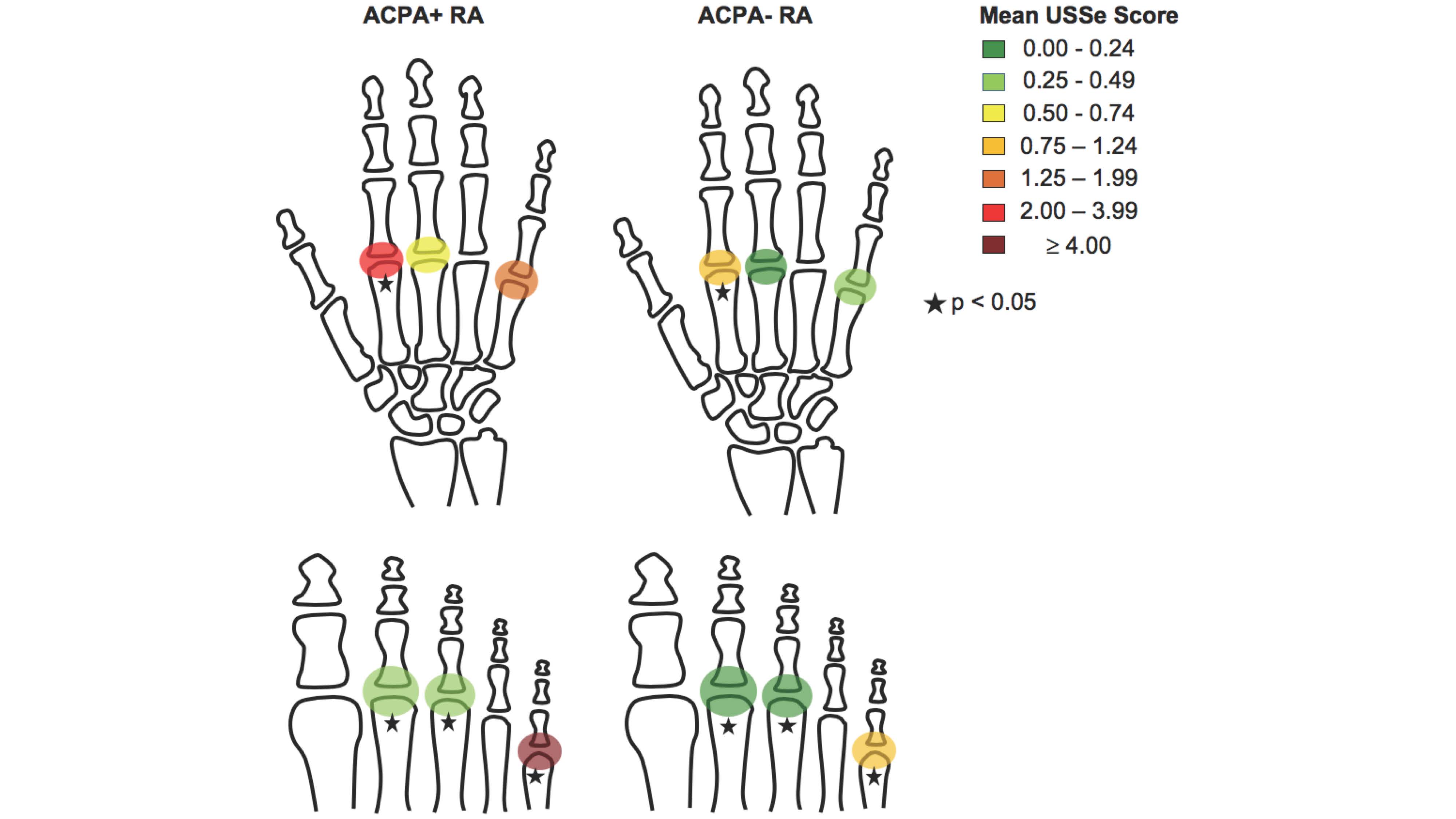Session Information
Date: Sunday, November 10, 2019
Title: RA – Diagnosis, Manifestations, & Outcomes Poster I: Risk Factors, Predictors, & Prognosis
Session Type: Poster Session (Sunday)
Session Time: 9:00AM-11:00AM
Background/Purpose:
Several studies have shown that ACPA-positive (ACPA+) patients were more likely to develop erosive disease on radiography (RX) than ACPA-negative (ACPA-) patients, but it has never been demonstrated on ultrasonography (US). The characteristics of bone erosions on both RX and US according to ACPA status has never been studied before. The objective of this study was to assess the prevalence, localization and severity of bone erosions on RX and US according to ACPA status in patients with rheumatoid arthritis (RA).
Methods:
78 patients with ACPA+ RA and 30 patients with ACPA- RA fulfilling the ACR 1987 and/or ACR/EULAR 2010 criteria were consecutively included. On RX, a modified Sharp erosion score (SHSe) was evaluated by two blinded readers and one adjudicator for discordant cases (number of eroded joints ≤ three). On US, erosions were scored on six bilateral joints (MCP2,3,5; MTP2,3,5) with a four-point scale to calculate the total US score for erosions (USSe).
Results: On RX, 33 ACPA+ RA patients (42.3%) and 4 ACPA- RA patients (13.3%) had an erosive disease according to the EULAR 2013 definition criteria. On US, 61 and 63 ACPA+ RA patients (78.2% and 80.8%) versus 14 and 10 ACPA- RA patients (46.7% and 33.3%) had an erosive disease according to the following two definitions: the presence of at least two eroded joint facets (def1) or at least one grade 2 eroded joint facet (def2), respectively.
Erosion patterns were different between ACPA+ RA patients and ACPA- RA patients. On RX, erosions were preferentially observed in MTP joints in the ACPA+ group and in wrists in the ACPA- group (Figure 1). On US, erosions were preferentially found in the lateral facets of MTP5 joints, followed by MCP2 and MCP5 joints in both groups (Figure 2).
On both RX and US, the most discriminating joint between the two groups was MTP5, especially in cases with bilateral erosion (17 ACPA+ RA patients versus 0 ACPA- RA patients on RX, 45 ACPA+ RA patients versus 1 ACPA- RA patient on US; p< 0.001).
The mean total SHSe were 15.3±22.1 and 4.1±8.3 in the ACPA+ and ACPA- groups, respectively (p< 0.001). The mean total USSe were 12.2±11.7 in the ACPA+ group and 2.8±4.4 in the ACPA- group (p< 0.001).
Based on multivariate analyses, ACPA+ status was associated with erosive RA on RX according to the EULAR 2013 definition criteria (OR 4.4 (95% CI 1.2-16.4)), and on US according to def1 (OR 3.7 (95% CI 1.4-9.9)) and def2 (OR 9.0 (95% CI 2.8-28.4)).
Conclusion: Compared to ACPA- RA, ACPA+ RA is associated independently with more severe erosive disease on RX and US. Both US and RX bilateral erosions in MTP5 joints are highly discriminant for ACPA+ RA patients (97.8% in US, 100% in RX).
To cite this abstract in AMA style:
Grosse J, Allado E, Roux C, Pierreisnard A, Couderc M, Clerc-Urmès I, Remen T, Albuisson E, De Carvalho M, Chary-Valckenaere I, Loeuille D. ACPA-positive versus ACPA-negative Rheumatoid Arthritis: Two Distinct Erosive Disease Entities on Radiography and Ultrasonography [abstract]. Arthritis Rheumatol. 2019; 71 (suppl 10). https://acrabstracts.org/abstract/acpa-positive-versus-acpa-negative-rheumatoid-arthritis-two-distinct-erosive-disease-entities-on-radiography-and-ultrasonography/. Accessed .« Back to 2019 ACR/ARP Annual Meeting
ACR Meeting Abstracts - https://acrabstracts.org/abstract/acpa-positive-versus-acpa-negative-rheumatoid-arthritis-two-distinct-erosive-disease-entities-on-radiography-and-ultrasonography/


